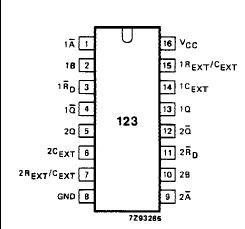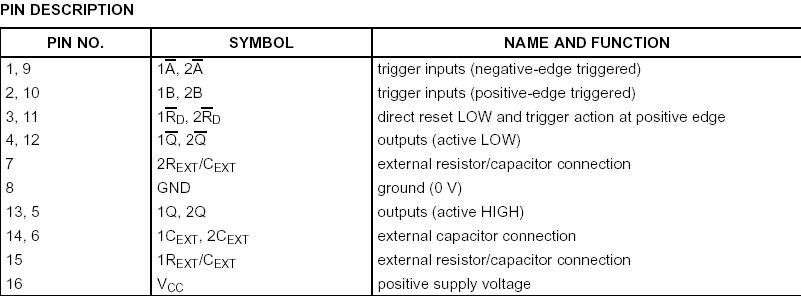Features: · DC triggered from active HIGH or active LOW inputs
· Retriggerable for very long pulses up to 100% duty factor
· Direct reset terminates output pulse
· Schmitt-trigger action on all inputs except for the reset input
· Output capability: standard (except for nREXT/CEXT)
· ICC category: MSI
Pinout
 Description
Description The 74HC/HCT123 are high-speed Si-gate CMOS devices and are pin compatible with low power Schottky TTL (LSTTL). They are specified in compliance with JEDEC standard no.7A.
The 74HC/HCT123 are dual retriggerable monostable multivibrators with output pulse width control by three methods. The basic pulse time is programmed by selection of an external resistor (R
EXT) and capacitor (C
EXT). The external resistor and capacitor are normally connected as shown in
Fig.6.
Once triggered, the basic output pulse width of the 74HC/HCT123 may be extended by retriggering the gated active LOW-going edge input (nA ) or the active HIGH-going edge input (nB).
By repeating this process, the output pulse period (nQ = HIGH, nQ = LOW) can be made as long as desired. Alternatively an output delay can be
terminated at any time by a LOW-going edge on input nR D, whic also inhibits the triggering.
An internal connection from nR
D to the input gates makes it possible to trigger the circuit by a positive-going signal at input nR
D as shown in the function table. Figures 7 and 8 illustrate pulse control by retriggering and early reset. The basic output pulse width is essentially determined by the values of the external timing components REXT and CEXT. For pulse widths, when CEXT < 10 000 pF, see Fig.9.
When C
EXT > 10 000 pF, the typical output pulse width is defined as:
tW = 0.45 ´ R
EXT ´ C
EXT (typ.),
where:
tW = pulse width in ns;
R
EXT = external resistor in kW;
C
EXT = external capacitor in pF.
Schmitt-trigger action of the 74HC/HCT123 in the nA and nB inputs, makes the circuit highly tolerant to slower input rise and fall times.
The '123' is identical to the '423' but can be triggered via the reset input.

 74HC/HCT123 Data Sheet
74HC/HCT123 Data Sheet








